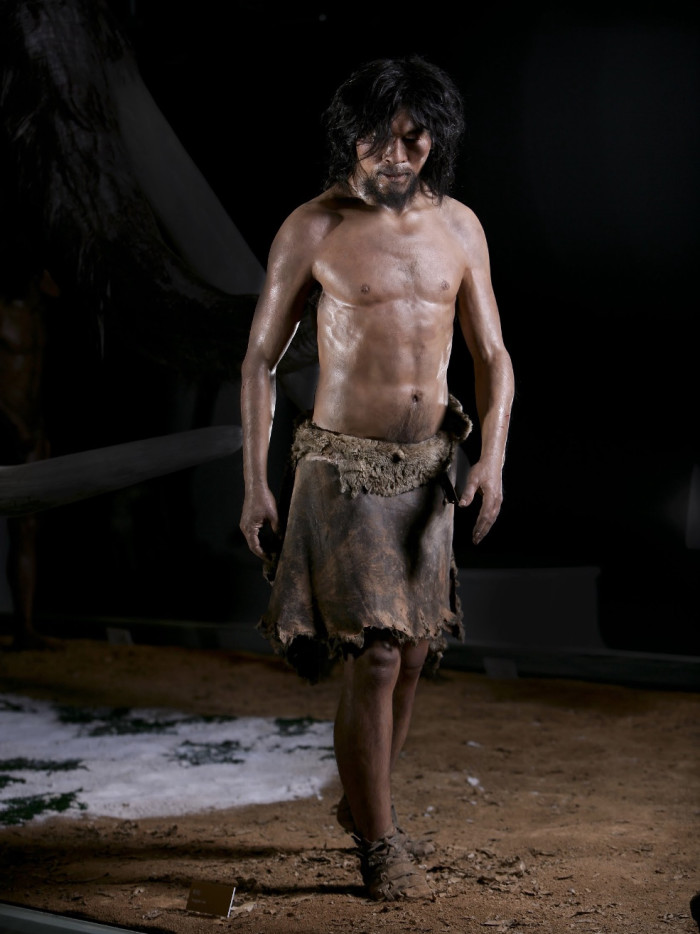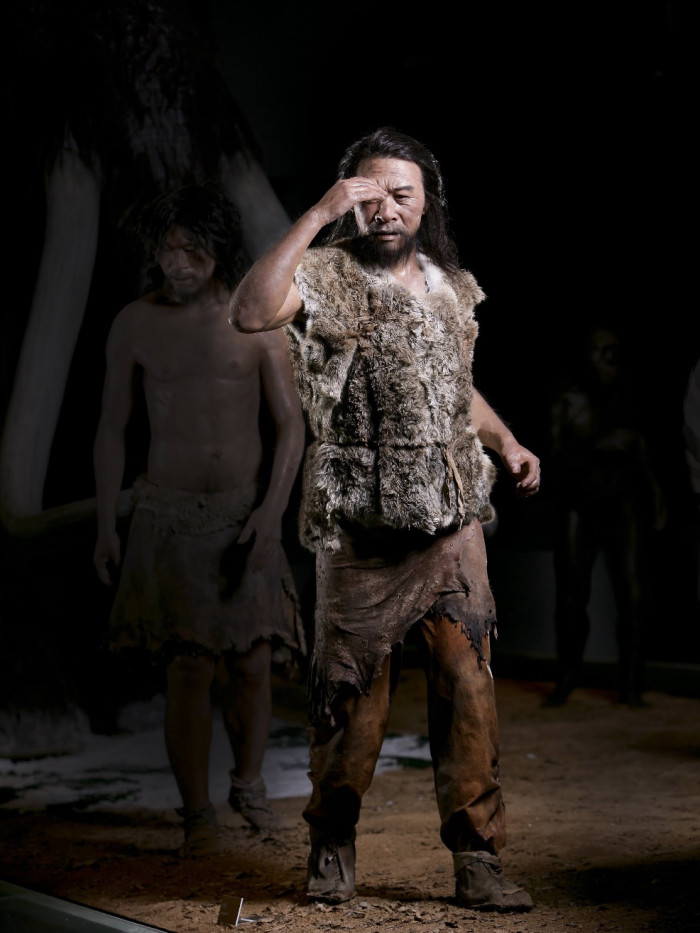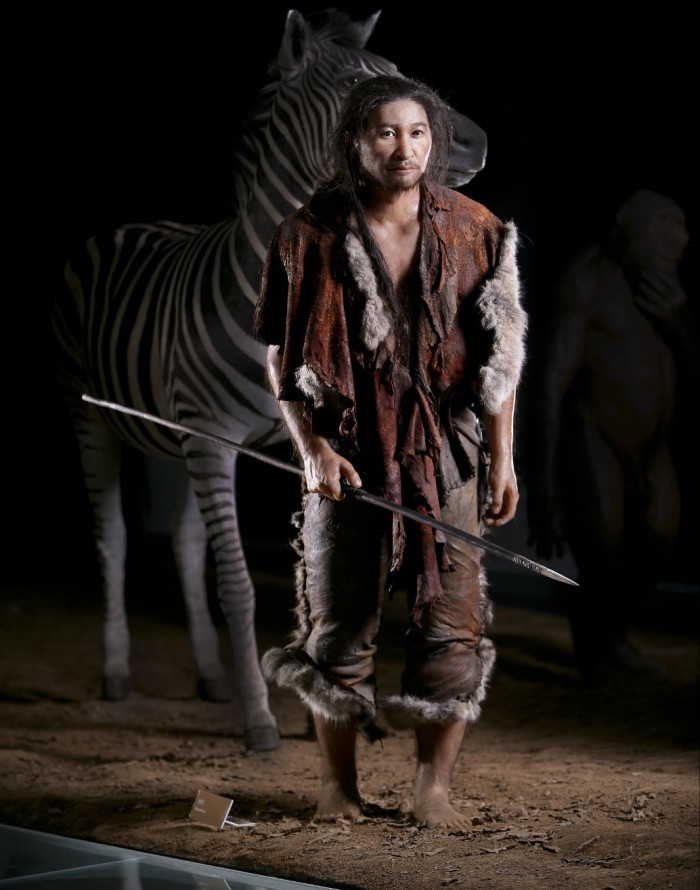지지씨
Evolution of Humanity, the Great March Forward - 3. Out of Africa - the emergence and dispersion of modern-day humanity

Place of Settlement: Near Pyeongyang in North Korea / Period: About 43,000-45,000 years ago / Discovery Site: Yonggok Cave, Pyeongyang, North Korea / Species: Homo sapiens / Cranial Capacity: 1,650cc / Major Characteristics: Yonggok Man represents the humans who lived on the Korean Peninsula during the Upper Paleolithic Age. The discoveries at the site include a skull and arm and leg bones.
Discovered at the cave site in Yonggok-ri, Sangwon-eup, near Pyeongyang in North Korea, Yonggok Man is an early human fossil of the Upper Paleolithic Age. Various relics from the Paleolithic and Neolithic Ages were discovered at two cave sites in Yonggok in 1980-81. The remains excavated from the Paleolithic cultural layers of Cave 1 include fossils of Homo sapiens, named Yonggok Man, stone tools, bone implements, animal bones, and flat-looking bone sculptures as well as a fire site. In addition, three humeri (upper arm bones) and six thigh bones were found in Yonggok Cave, from which it has been estimated that Yonggok Man stood about 167-175cm tall. Although Yonggok Man had ‘modern’ cranial features such as a high vaulted skull with a well-developed forehead, some primitive types of quartz stone implements were also discovered there.
Yonggok Man is believed to have lived around 43,000-45,000 years ago. The discovery of the remains of different species of animals at Yonggok Cave indicates a Paleolithic environment at that time. The remains of animals such as water buffalo or Dierrorhinus kirchbergensis that lived in a warm climate were found in the lower layers of the Paleolithic Age, while the remains of animals that lived in a temperate or subarctic climate were found in the upper layers. Yonggok Man is an important basis for estimating the appearance of humans on the Korean Peninsula during the Upper Paleolithic Age.

Place of Settlement: Around Beijing, China / Period: About 18,000 years ago / Discovery Site: The Upper Cave at Zhoukoudian, near Beijing, China / Species: Homo sapiens / Cranial Capacity: 1,600cc / Major Characteristics: Use of bone needles, burial rites.
In 1933, fossil remains of what is now known as Upper Cave Man were discovered on the upper part of Dragon Bone Hill where Beijing Man was also found. Although the Upper Cave Man fossils date back about 18,000 years, the shape of the skulls and the length of the arm and leg bones display the characteristics of modern humans. The average height of the men was 174 cm while that of the women was 159cm (i.e. not significantly different to us), and their cranial capacity was also similar to that of modern humans. In addition, various relics such as tools and ornaments made from stone and bone attest to their technical skills and artistic sensibility. Furthermore, the red iron ore powder found sprinkled around the human remains has been interpreted as evidence that they practiced burial rites for the dead. Furthermore, a bone needle unearthed from the site indicates that they were skillful makers of clothing. In total, the fossils of 118 species of animals were found at the Upper Cave site, some 30 of which are extinct. As the fossils of animals that typically lived in tropical regions - such as leopards, ostriches, and Asian elephants - were also discovered there, it is assumed that the temperature of the region was much higher at that time than it is now. Upper Cave Man exhibited similar physical characteristics to modern East Asians. Indeed, if he were standing in front of us right now, wearing the same clothes as us, we might not be able to tell him apart.

Place of Settlement: Around Pyeongyang, North Korea / Period: About 10,000-12,000 years ago / Discovery Site: Mandal Cave, Pyeongyang, North Korea / Species: Homo sapiens / Nick-name: Mandal Man / Cranial Capacity: 1,676cc / Major Characteristics: The fossil remains of ancient humans who lived between the Upper Paleolithic and Neolithic Age.
The ancient human fossil remains of what is now known as Mandal Man were discovered at a cave site of the Upper Paleolithic Age, at Mandalsan Mountain, Seungho County, Pyeongyang, North Korea. Mandal Man’s frontal bone, parietal bone, occipital bone, and lower jaw were unearthed from Mandal Cave. The fossils, which belonged to a man aged 25-30, were given the name ‘Mandal Man’ after the discovery site. There are no significant differences in terms of the overall skull development, brow ridges, and lower jaw between Mandal Man and modern humans. The environment of the period in which Mandal Man lived can be explained by the many animal remains - including extinct animals such as monkeys, woolly rhinoceros, horses, Bos primigenus Bojanus, cave bears, cave hyenas, and cave lions, as well as animals that typically lived in a warm climate such as monkeys and water deer - that were also found along with the Mandal Man fossils. Mandal Man is now believed to have lived at the end of the Upper Paleolithic Age, around 12,000 years ago, and is regarded as a member of the people who lived on the Korean Peninsula during the transition from the Upper Paleolithic Age to the Neolithic Age. However, it is still uncertain whether Mandal Man is a direct ancestor of modern Korean people.
<ggc의 모든 콘텐츠는 저작권법의 보호를 받습니다.>
- 글쓴이
- 지지씨
- 자기소개